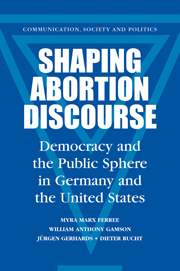Book contents
- Frontmatter
- Contents
- Tables and Figures
- Foreword by Friedhelm Neidhardt
- Preface
- Glossary
- Part I Introduction
- Part II Major Outcomes
- 4 The Discursive Opportunity Structure
- 5 Standing
- 6 Framing
- Part III Representing Different Constituencies
- Part IV The Quality of Abortion Discourse
- Methodological Appendix
- References
- Index
4 - The Discursive Opportunity Structure
Published online by Cambridge University Press: 15 December 2009
- Frontmatter
- Contents
- Tables and Figures
- Foreword by Friedhelm Neidhardt
- Preface
- Glossary
- Part I Introduction
- Part II Major Outcomes
- 4 The Discursive Opportunity Structure
- 5 Standing
- 6 Framing
- Part III Representing Different Constituencies
- Part IV The Quality of Abortion Discourse
- Methodological Appendix
- References
- Index
Summary
In 1931, a lively framing contest over abortion policy in Germany reached a peak. Hundreds of new groups were created, and there were more than 1000 local demonstrations in support of lessening or removing legal restrictions on abortion, with appropriate coverage in the mass media of the day. Move the clock forward two years, after the Nazis seized power, and the whole scene seems unimaginable. The playing field in which any framing contest about abortion that was being waged was so radically different that the once taken-for-granted became unthinkable. The idea that one could further abortion reform through mass demonstrations and public discourse might as well have come from the moon.
Under the new regime, abortion was framed as a tool for “race hygiene” (Czarnowski 1997; Koonz 1986). Coercive sterilization and abortion were means for preventing inferior races from reproducing. Aryan women, in contrast, had a responsibility to the state to reproduce, and abortion was a criminal act. In 1943, a woman who had more than one abortion was threatened with capital punishment for “repeatedly undermining the vitality (Lebenskraft) of the German people.” No alternative frames were permitted in this arena (Koonz 1986).
The shift from the Weimar Republic to the Nazi regime is an extreme case of a changing context for abortion discourse. The differences between the United States and Germany and the changes over the past 30 years are certainly less dramatic.
Information
- Type
- Chapter
- Information
- Shaping Abortion DiscourseDemocracy and the Public Sphere in Germany and the United States, pp. 61 - 85Publisher: Cambridge University PressPrint publication year: 2002
